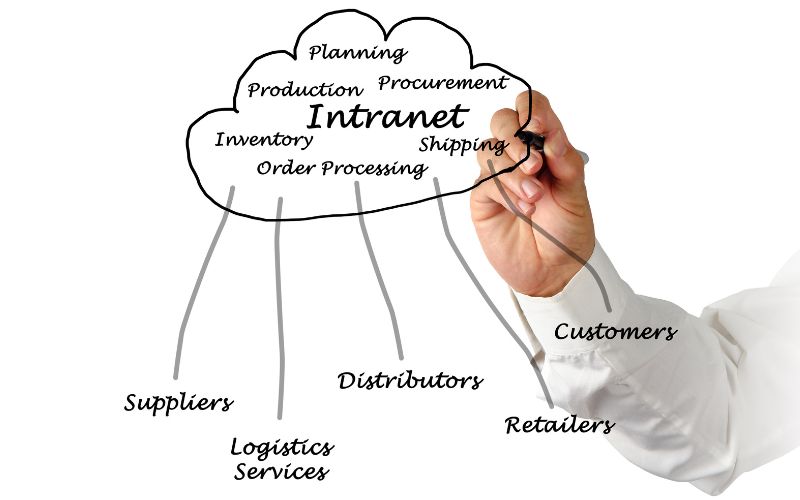If it has ever been recommended that you invest in a company intranet, you may wonder what exactly this is and why it can be so beneficial for your organization. Many larger companies need intranets, especially those that have multiple locations, but there are also smaller businesses that can benefit from the addition of a company intranet, too.
Read on to learn more about intranet in this article, including what it is and its benefits so that you can understand how an intranet system can be a great asset for your business.
- What Is An Intranet?
- Benefits of Intranet
- Frequently Asked Questions
What Is An Intranet?
First things first, what is an intranet? Essentially, the intranet definition is a private network or web server accessible only to an organization’s staff. Often, it comprises a wide range of information and services from the organization’s internal IT systems that are designed to assist employees in their work. It may include tools for communication, collaboration, business operations, and management applications, as well as resources like company policies, training materials, and internal news. Essentially, an intranet serves as a digital hub for a company, enabling employees to share information, manage projects, and communicate more efficiently within a secure and controlled environment.
We will go over the benefits of having an intranet in further detail below, but this system is used for helping employees to stay in contact and helping them to easily share information, even across different time zones and locations.

Benefits of Intranet
Take a look below for a roundup of some of the main and greatest benefits of an intranet so that you can decide whether it would be a good choice for your organization.
Improved Internal Communication
One of the many great benefits of an intranet is that it provides better internal communication throughout your company and team— and even across teams! This is also the main benefit of an intranet and the one that the system was largely designed to provide. An intranet’s function is to support and streamline communication of the team internally. Intranets can centralize all of the company communications, which then makes it easier for employees to interact, communicate effectively and get into the ecosystem of a company. It fosters the employee experience and teamwork within a company, leading to increased productivity and efficiency.
Easier to Find Information
An intranet also makes it easier for employees of a company to find information. This, like improved internal communication, is another core benefit of implementing an intranet system. The document management systems will store all sorts of information and company knowledge in its centralized location so that it can be found and then accessed quickly and easily. So, whether a person or new employee is looking for an organizational flow chart or company news, it will be easy to find with the use of the company’s intranet.
Connectivity Across Geographic Locations
Depending upon how large your company or organization is, a corporate intranet can also help to connect your employees and team members across locations and time zones. After all, there are organizations that have more than one location, whether they be in different cities or even different countries! This can also be helpful if you have teams or employees who work remote. Even when these employees are remote workers and not physically close to one another, they are still able to effectively communicate with the help of an intranet system.
Improved Employee Engagement
A well-designed company intranets provide employees with tools and resources that empower them to be more engaged and connected to the company. It can facilitate employee self-service, training and development opportunities, and recognition programs, which can boost morale and job satisfaction.
Recent studies show that 74% of employees are actively looking for new jobs or new employment opportunities. However, an intranet can help prevent this and increase employee engagement at your company. For instance, if the employees have a place to connect, like your intranet system, then they will feel much more like a part of the team and this will make them happier and less likely to look elsewhere. It can also help improve company culture when employee engagement is increased. There can also be an internal job board to engage employees to look within for new opportunities.
Reduced Meetings and Emails
Another benefit of an intranet is that it is able to reduce meetings and emails, which can be a time suck! This is due to the better access to resources that an intranet offers, so employees will not need to ask as many questions. They will also make fewer mistakes and there are less opportunities for miscommunications or the spread of any misinformation.
Security and Data Control
Investing in an intranet platform allows you to have better control over sensitive data and internal information. This private internal network provides security features and access controls to ensure that confidential data remains protected within the organization.
An intranet platform can help with security and data control in several ways:
- Access Control: Intranet software allows you to set access controls and permissions, ensuring that only authorized employees have access to specific information and resources. This helps to protect sensitive data from unauthorized access.
- User Authentication: Intranets often require user authentication, such as username and password, to access the platform. This helps verify the identity of users and prevents unauthorized individuals from accessing confidential information.
- Data Encryption: Intranets can use encryption techniques to protect data transmitted over the network. Encryption ensures that data is secure and can only be accessed by authorized individuals with the decryption key.
- Secure File Storage: An intranet can provide a secure storage system for files and documents. It allows you to control access to files, set permissions, and track file activity, ensuring that sensitive data is protected and shared appropriately.
- Auditing and Monitoring: Intranets can have auditing and monitoring features that track user activities and provide logs of system interactions. This helps detect any suspicious or unauthorized activities and allows for timely action to mitigate potential security risks.
- Regular Updates and Patches: Intranet platforms are typically regularly updated and patched to address security vulnerabilities and ensure the system remains robust against emerging threats. Staying up to date with the latest security updates helps protect against potential breaches.
Scalability and Customization
An intranet can be customized and scaled to meet the specific needs of your organization. Whether you have a small team or a large enterprise, a well-designed intranet can adapt and grow with your business.

Frequently Asked Questions
What are 5 benefits of intranet?
Intranet has so many benefits and can be helpful for different purposes or businesses and aid in a company’s success depending upon their characteristics or needs. First things first, a company intranet portal is what is known as a local or restricted communications network, such as a private network created with the use of world wide web software.
Five of the business intranet benefits, with a focus on engaging and recognizing employees, are as follows:
- An intranet simplifies the employee onboarding process and can engage employees, making new hires feel welcomed and valued from the start.
- Through improved internal communications, an intranet ensures employees access timely, relevant information, fostering a more connected and informed workforce.
- By providing organizational clarity, an intranet empowers employees with a clear understanding of their roles and the company’s goals, which helps to encourage employees to align their efforts with the organization’s vision.
- An intranet encourages knowledge sharing within the company or across teams, facilitating a collaborative environment where employee recognition is part of the culture.
- An intranet seamlessly connects your organization across time zones and locations, enabling employees to engage with one another more efficiently, regardless of geographical barriers.
A modern intranet solution enhances all these benefits through thoughtful context, design, and acceptance. When the intranet mirrors the intuitive and easy-to-use interfaces that employees encounter in their daily lives, they are more likely to engage with it regularly. This familiarity simplifies the integration process, making it easier for employees to access, share knowledge, and feel recognized for their contributions.
What is one benefit of having an intranet?
There are plenty of benefits to having a company intranet. So, if you are wondering if intranet solutions can help your company, organization, or team, the answer is yes! An intranet can certainly assist you in your day to day and bring you lots of different types of benefits including in the aid of company culture. Of course, the benefits that you find most valuable will depend upon your organization, company values and its individual needs.
One of the biggest benefits of having an intranet to work on in your organization is that it can connect employees by assisting you and your team with internal improved communication. An intranet is great for centralizing all workplace communications, which therefore makes it easier to interact with other employees with instant messaging, no matter what team they are on or where they are located. This is a benefit that can be hugely important no matter what your organization does or needs.

What is an intranet and what is its purpose?
You may have heard or seen the term intranet and wondered what it meant— or perhaps you thought someone was saying internet wrong! Well, an intranet is kind of like an internet, though it does not mean the same thing. An intranet is an internal, local or restricted network. It can be compared to the internet in that it is kind of like an internal internet platform that is used by your team or your company only.
The purpose of the intranet system is, essentially intranets enable employees to stay up to date with their company. It helps facilitate easier communication and collaboration, among other things. It also works as a website, communication channel, collaboriation platform, and a knowledge management tool.
What is an example of an Intranet?
An intranet is a private digital platform within a network, promoting communication, collaboration, and information sharing among employees. It serves as an internal hub using intranet software for resources, documents, and tools, streamlining tasks.
In the modern business landscape, the corporate intranet goes beyond information storage. It’s interactive, leveraging team-focused tools like chat, calendars, and project management to boost teamwork and innovation. Employees engage in real-time discussions and share ideas, transcending physical locations while creating a more digital workplace.
The intranet’s essence lies in quick and secure access to crucial data. It’s a repository for documents from company policies to FAQs, ensuring up-to-date resources and efficient retrieval.
Additionally, a well-designed company intranet enhances organization’s employees communication, disseminating announcements and updates to all employees. It addresses security concerns by operating within a private network, restricting access to authorized personnel. This environment encourages open sharing while protecting sensitive information.
Leveraging intranet software and collaboration tools, a modern intranet empowers employees to collaborate, access resources, and strengthen internal communication securely. This digital shift optimizes operations, fostering a connected workforce in the organization’s private domain.
A real-world example of a company intranet is Microsoft SharePoint. SharePoint is a widely used platform that provides organizations with a comprehensive intranet solution. It offers features such as document storage and sharing, team collaboration spaces, discussion forums, announcement boards, and integration with other Microsoft tools like Office 365 applications.
Within SharePoint, employees can access important documents, collaborate on projects, and communicate with colleagues seamlessly. It provides a centralized space where teams can work together on tasks, share knowledge, and stay updated on company news and announcements. SharePoint’s user-friendly interface and integration capabilities make it an effective tool for enhancing internal communication and collaboration within an organization.
What is the Difference Between an Intranet and the Internet?
The primary distinction between an intranet and the internet lies in their scope and purpose within an organization’s digital landscape.
The Internet is a global network that connects millions of devices worldwide, enabling access to vast amounts of information, services, and resources. It’s a public domain used for various purposes such as communication, research, and entertainment.
In contrast, an intranet is a private network accessible only within a specific organization. It serves as a digital workplace, using intranet platforms to facilitate communication, collaboration, and information sharing among employees. While the internet spans globally, an intranet is localized to the organization, promoting secure data sharing and task coordination.
Moreover, traditional intranets primarily offered static content, limiting interactivity and engagement. However, modern intranet platforms are dynamic, incorporating collaboration tools and enabling real-time employee feedback. This fosters a more agile and connected workforce, enhancing productivity and innovation.
What Types of Companies and Industries Benefit from Intranet Software?
Intranets benefit a wide range of companies and industries by enhancing internal communication tools, streamlining processes, and fostering a collaborative work environment. Here are some company intranet examples and sectors that particularly benefit from implementing an intranet site:
- Corporations and Large Enterprises: With departments and teams often spread across various locations, intranets help large organizations stay connected, share knowledge, and maintain a unified corporate culture.
- Healthcare: Hospitals and healthcare providers use intranets for secure communication, accessing patient records, scheduling, and providing staff with critical updates and training materials.
- Education: Schools, universities, and educational institutions leverage intranets to distribute course materials, facilitate communication between faculty and students, and manage administrative tasks.
- Government and Public Sector: Intranets assist government agencies in disseminating policies, streamlining internal processes, and providing a central point for employees to access important information and services.
- Finance and Banking: These sectors use intranets for secure communication, managing financial transactions, sharing market insights, and complying with regulatory requirements.
- Technology and IT Companies: For organizations that thrive on innovation, intranets are crucial for sharing technical documentation, managing projects, and fostering collaboration among developers and technical teams.
- Manufacturing and Supply Chain: Intranets help these industries monitor production processes, manage inventory, share safety protocols, and communicate across different parts of the supply chain.
- Retail: Retail companies use intranets for training staff, managing inventory, sharing sales strategies, and communicating across stores and distribution centers.
- Hospitality and Travel: Hotels, airlines, and travel agencies use intranets to schedule staff, manage reservations, communicate with guests, and provide training materials.
- Non-Profit Organizations: Intranets support non-profits in volunteer management, fundraising activities, and spreading their message to staff and volunteers.
In essence, any organization looking to improve internal communication, enhance productivity, and securely manage information can benefit from an intranet for internal and external resources, regardless of its size or industry.


